Engineering: The hands and feet of Jesus
2024 marks 20 years since Lipscomb’s first engineering mission trip, a milestone that sparked 88 projects that have benefited thousands upon thousands of people around the globe.
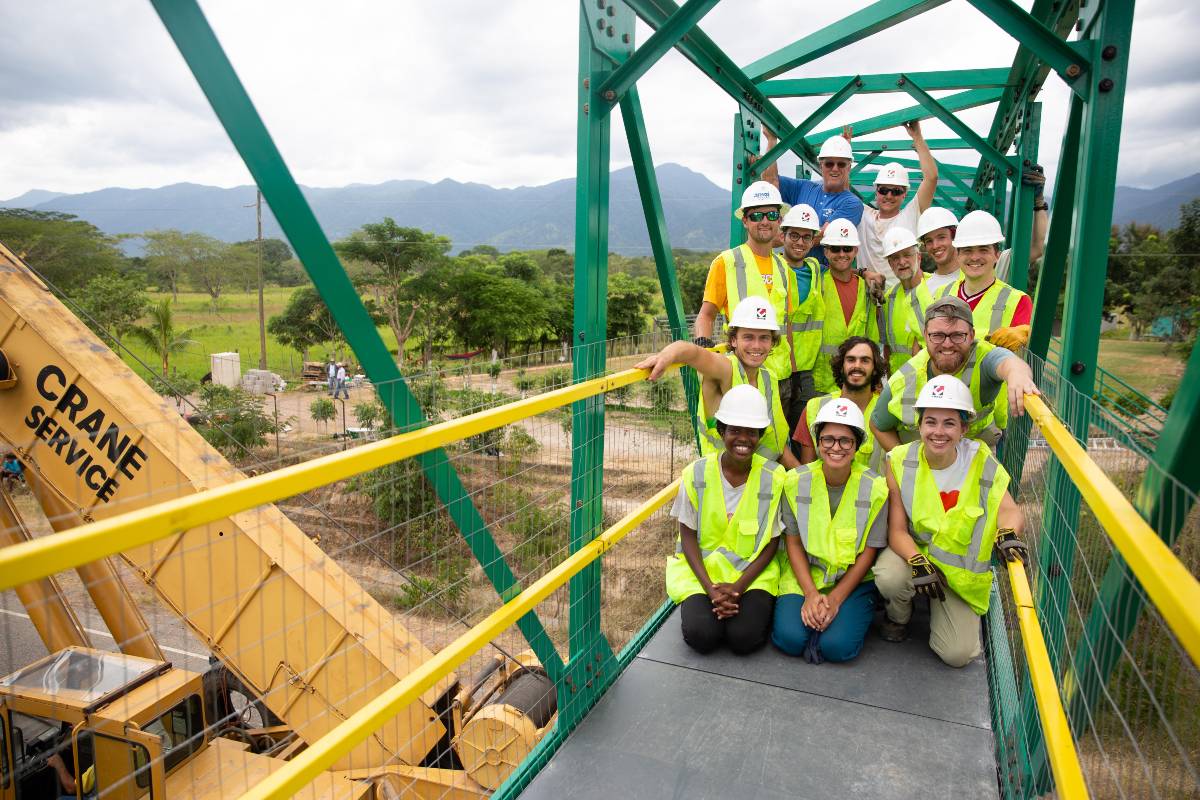
This 104-foot-long pedestrian bridge in Honduras is one of almost 90 projects the Raymond B. Jones College of Engineering has implemented both near and far. The engineering students who helped make this happen won a national award for this bridge project.
It began with a handful of students and a 300-gallon water tank.
In 2003, then-computer engineering faculty David Fann was fresh off a summer spent in Honduras, doing mission work with his wife, when a few engineering students approached him with an idea: an engineering-focused mission trip.
Their suggestion was right in line with what Fann had been mulling over lately. “You don’t have to be a minister to do work for the glory of God.”
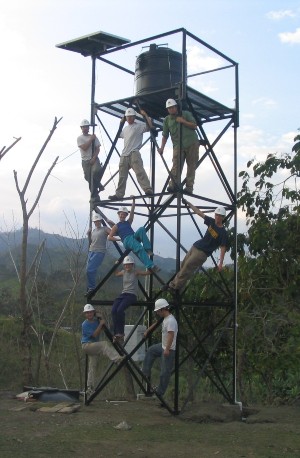
The first project in Las Delicias, Honduras, provided a consistent water supply for Mission Predisan.
“I felt like engineering could enable mission organizations already active on-site to become much more successful,” said Fann. “It also felt like a way students could see how the concepts they learn in classes could be used to the glory of God.”
Twenty years later, the Raymond B. Jones College of Engineering has coordinated hundreds of students to implement up to eight international and domestic engineering projects annually including bridges, solar installations, water distribution and wastewater management systems that directly impact the lives of more than 56,000 people—and that’s a low estimate.
Their work has been praised by two national presidents, of Honduras and of Malawi, and the college counts national organizations in the U.S. and abroad among its partners.
On top of the life-changing direct impact these projects have on communities in seven nations, the college has also established an administrative hub for missions—the Peugeot Center for Engineering Service in Developing Communities; has hosted a national conference on engineering missions; and is carrying out a federally-funded research study on the impact of humanitarian missions.
But back during spring break in 2004, it was just about getting one water tank up on a tower.
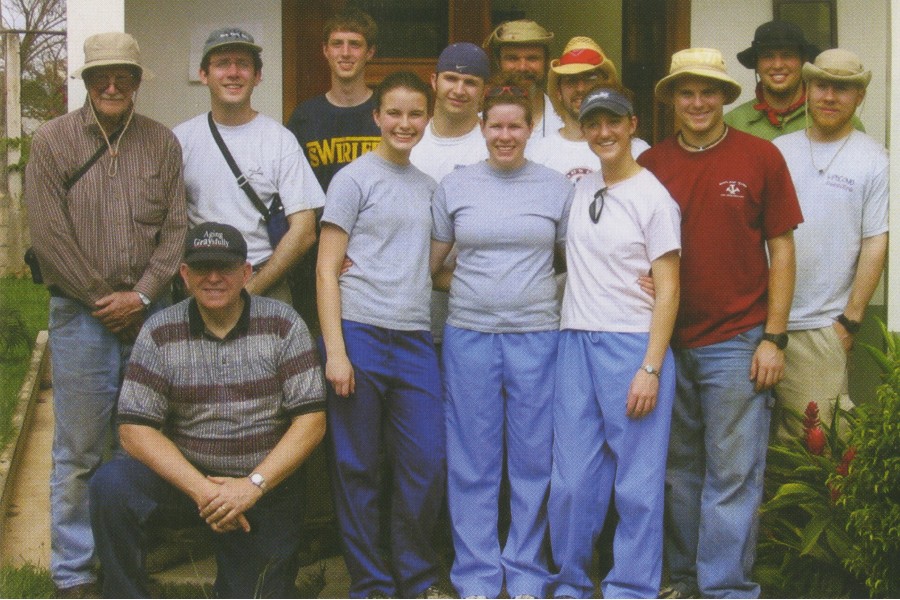
Members of the original 2004 Team (not in order): Fred Gilliam, Kristopher Hatchell, Chad Jacobs, Kathryn (McDonald) Kornrumpf, Amy (Gilfilen) Lucas, Matthew Lucas, Kirk Pippin, Karla (Childress) Rodkey, James Savage, Matt Sheppard and Lee Whitney.
Nine students, two professors and an alumnus (Lee Whitney (A ’54)), a retired engineer in Middle Tennessee) traveled by plane, then car and then horseback to reach the rural Honduran community of Las Delicias, which serves as home base of operations for Mission Predisan, a Christian medical outreach organization that Fann knew had a need for infrastructure. The organization uses a site in Las Delicias as a basecamp for roving health professionals to hold clinic days in even more remote areas in the surrounding mountains.
The team brought everything they needed with them to construct—in just four days—the 20-foot water tower and tank equipped with a solar-powered pump. The tower, intended to provide a reliable water source in a community with no electricity, had been designed by students and faculty in Lipscomb’s structural design course taught by Fort Gwinn, then chair of the engineering mechanics department.
That first project established the basic parameters still followed by the engineering college today: 1. engineering staff identify a need through a partner organization, 2. students are involved in the design work guided by technical mentors, and 3. students have the opportunity to travel to the on-site location to support project implementation.
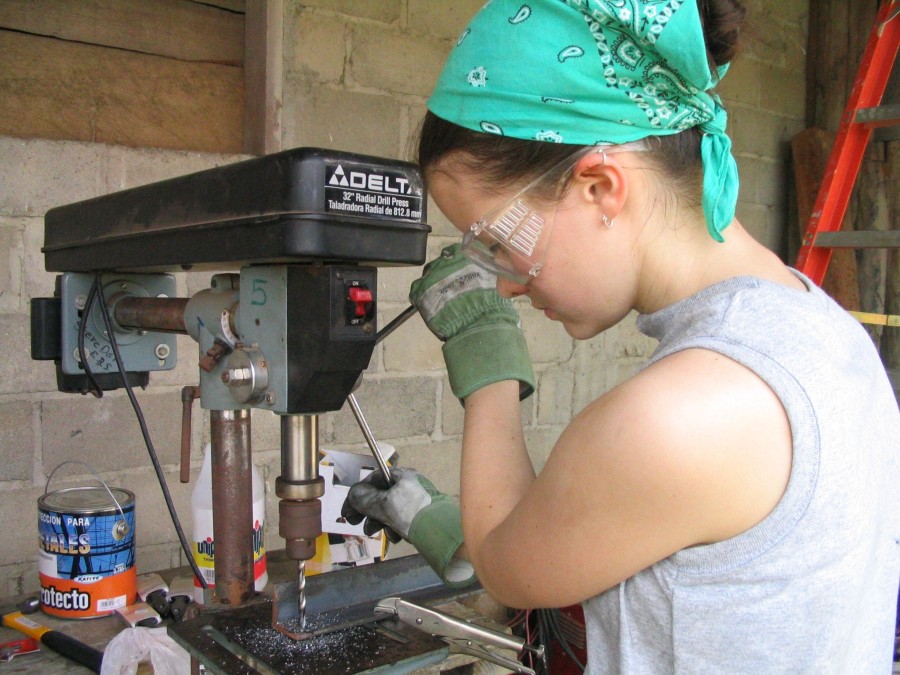
Amy (Gilfilen) Lucas (BS ’07) working on a drill on the first mission trip in 2004. The cutting oil the team brought with them got confiscated at the airport, so alumnus Lee Whitney came up with the idea to use pig lard bought at the market.
It’s a formula that not only brings life-changing resources to developing communities, but it also brings life-changing insight and spiritual formation to future engineers.
“The mentoring that happened on that trip was one of the highlights of my life,” said Fann. “It was life-changing for me and many of the students.”
“This trip changed me as a person and as a child of God in ways that I am still discovering today,” James Savage (BS ’04) said in the days after the 2004 trip. Savage was one of the students who originally approached Fann about a mission opportunity and a participant on the first trip.
Karla Childress (BS ’05), also a participant on that original trip, summed it up succinctly in 2004: “God is, like, the best engineer.”
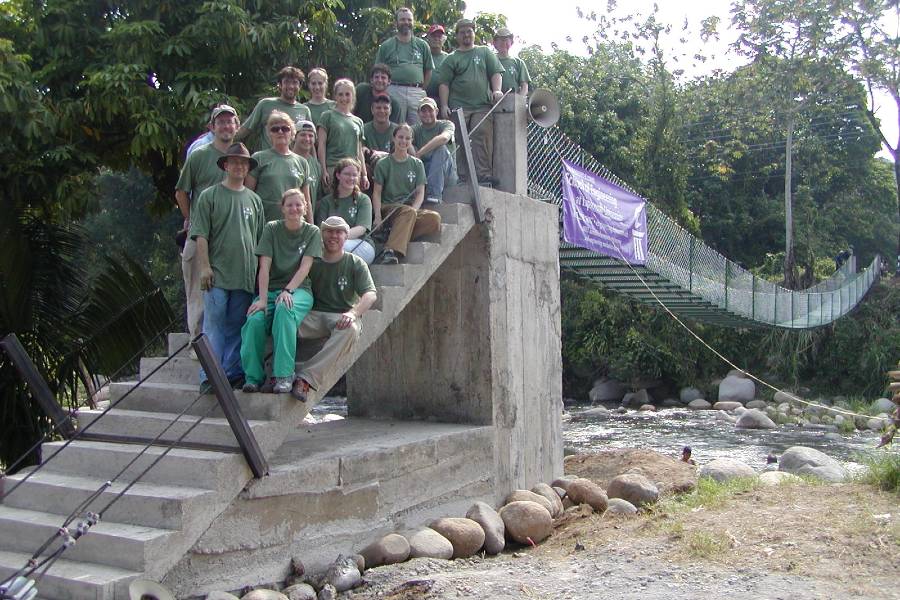
This bridge in Chicacao, Guatemala, in 2006 was the first to involve local residents helping with the build. Residents of the nearby communities built the two concrete platforms on either side of the river to anchor the footbridge before the team arrived.
Developing a formula for success
At first, the college stuck with what worked and sent additional teams to Honduras to implement additional projects for Predisan, including a project by computer engineering students to create an open-sourced database to track patient information at the Predisan clinic in Catacamas.
But in 2006, a new partner brought an opportunity that would prove to become a mainstay of Lipscomb’s engineering mission program: building bridges.
During May, a 19-person team traveled to Chicacao, Guatemala, to rebuild a 130-foot long footbridge that had been washed away in a 2005 flood. The bridge was the only access for two communities to the main road and to health care at Clinica Ezell, operated by Health Talents International. It was used by as many as 10,000 people per year, and without the bridge, the local residents were forced to travel three miles upstream to cross the river.
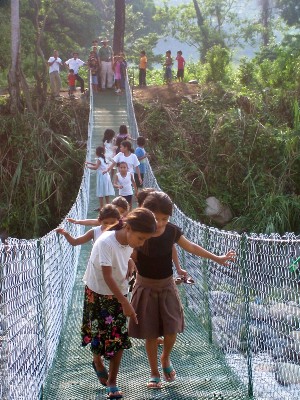
130-foot-long footbridge in Chicacao, Guatemala, rebuilt after being washed away in a flood.
The project set an important precedent in another way as well. For the first time, Lipscomb’s engineers relied on the locals to contribute work to the construction of the project.
“In every sense, this project was a partnership with them,” said Fred Gilliam, then professor and associate dean of engineering and later the founding dean of the Raymond B. Jones College of Engineering. “A partnership in planning, in labor, in finances and most especially in Christian spirit.”
The two mission teams that year also began a tradition of providing STEM education to local students, led by alumna Iris Whitney (A ’53), wife of Lee Whitney and a Bedford County teacher who guided engineering students to present valuable science lessons.
“It made sense to do science experiments and fun stuff with the kids,” said Gwinn, who retired this past year as associate dean of the college. “So that became an important part of the trips. Sometimes it’s just playing soccer or doing science workshops, but it’s always connecting with the children in the community.”
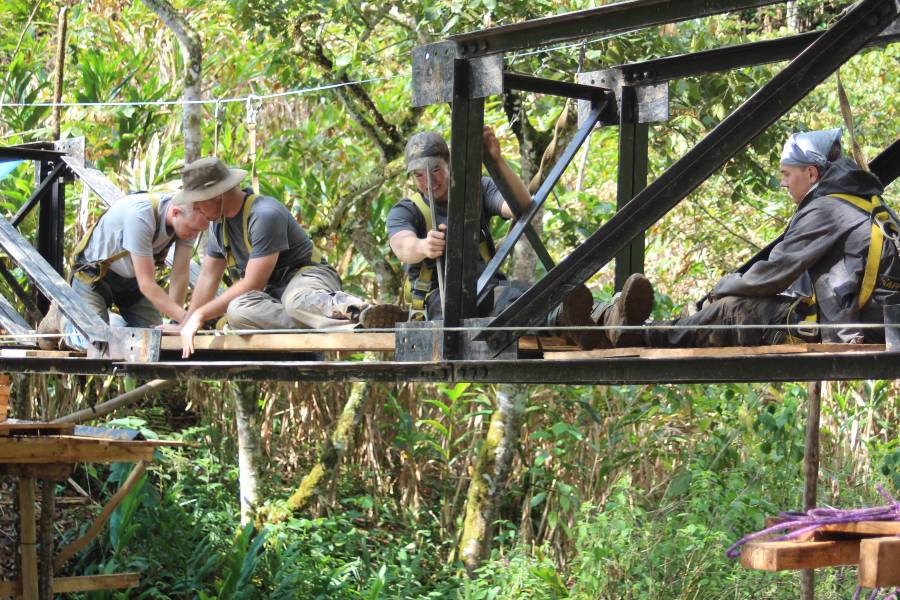
In 2009, the college began a long-term mission project in the Ulpan Valley in Guatemala, where student teams helped install solar-powered cell phone charging stations, a rainwater catchment system, a bridge and water distribution systems.
Simple solutions to make a big difference
In 2009, the college began its most consistently long-term mission project in the Ulpan Valley in Guatemala, one of the least served areas in the nation.
“You are there for a week or 10 days and then you are gone. There is not much continuity and there is not much you can do to build on what you did a year ago,” said Kerry Patterson, mechanical engineering faculty at the time, explaining many organizations’ typical approach to mission work in 2010.
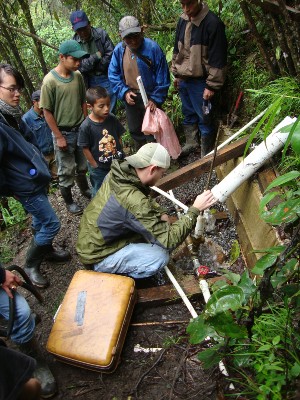
Kris Hatchell (kneeling down) was a participant on the first 2004 trip and worked with engineering missions in Guatemala and on-campus for several years after.
Reflecting an interest in providing sustainable improvement to one disadvantaged area, the college partnered with on-site missionaries and the non-governmental organization CAFNIMA from 2009 to 2015 to carry out various infrastructure projects in an area where 88% of the people—Q’eqchi’ Mayans—live in poverty.
One of those on-site missionaries was Kris Hatchell (BS ’06), an engineer who was a participant on the first engineering mission trip in 2004. He and local engineer Kevin Colvett, a long-time partner of engineering missions with InFlo Design Group, guided student teams to help install solar-powered cell phone charging stations, a rainwater catchment system and water distribution systems.
“While many engineers focus on high-tech solutions, there’s a need for simple solutions to basic problems that are a matter of life and death for people,” John Elrod (BS ’11), an engineering student from Manchester, Tennessee, who worked on one of the Ulpan Valley projects, said in 2010.
The joy of seeing lives changed
Ten years after the first trek to Honduras to build a water tank tower, Lipscomb had sent more than 200 students, 12 faculty and about 30 engineering professionals to four nations to build four bridges and install 12 water projects impacting well over 10,000 people.
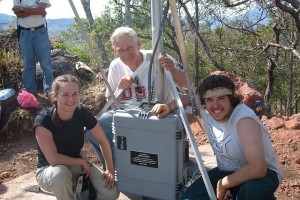
Working with students on this 2006 trip to install a radio tower for Predisan in Honduras inspired Dick Peugeot (center) and his wife Mary Ann to fund a missions center.
The program was well-embedded, but college leaders saw the potential to make the program bigger and better. In the same vein as their Ulpan Valley project, they wanted engineering missions to be sustainable over the long-term.
“We realized that we needed to have a more defined structure to spotlight missions, instead of it being just professor-driven,” said Justin Myrick, dean of the engineering college at the time. “A center would not only coordinate mission trips, but also develop partnerships with other organizations to do humanitarian engineering.”
“We’re trying to develop in all of our students, whether they go on a missions trip or not, a perspective of service in their profession, and the ones who do go on a missions trip, get a double dose of that service,” said Patterson, who become the Peugeot Center’s founding director in 2014.
Dick Peugeot, a 17-year Lipscomb trustee and an electrical engineer retired from Oak Ridge, Tennessee, and now living in Atlanta, and his wife Mary Ann made that goal possible by financially supporting the creation of the Peugeot Center to supervise the fundraising and strategic organization of service-oriented, holistic, long-term community change through engineering missions.

Kerry Patterson, was on the mechanical engineering faculty and later became the first director of the college’s Peugeot Center.
Dick Peugeot had been a participant in Lipscomb engineering missions several times, beginning with a 2006 trip to install a radio repeater tower in Honduras to enhance Predisan’s communication with their mountain clinics.
“I am very interested in being the hands and feet of Jesus and ways to spread the word of the Gospel,” said Dick Peugeot. “This concept of the engineering mission trip has developed legs of its own and has grown beyond what we could have imagined. It shows the power of God.”
“As soon as there is a mission trip, we have all the participants over to our house to hear all the stories, which are just amazing,” said Mary Ann Peugeot. “The students’ lives change; the people’s lives change; our lives have changed, and we have the joy of seeing it all happen.”
By keeping the organization all in-house, and working with specific, selected partners, Lipscomb is able to more easily “cut through” the red tape of international dealings and make sure all the legal and health issues are covered on the front end, said Gwinn.
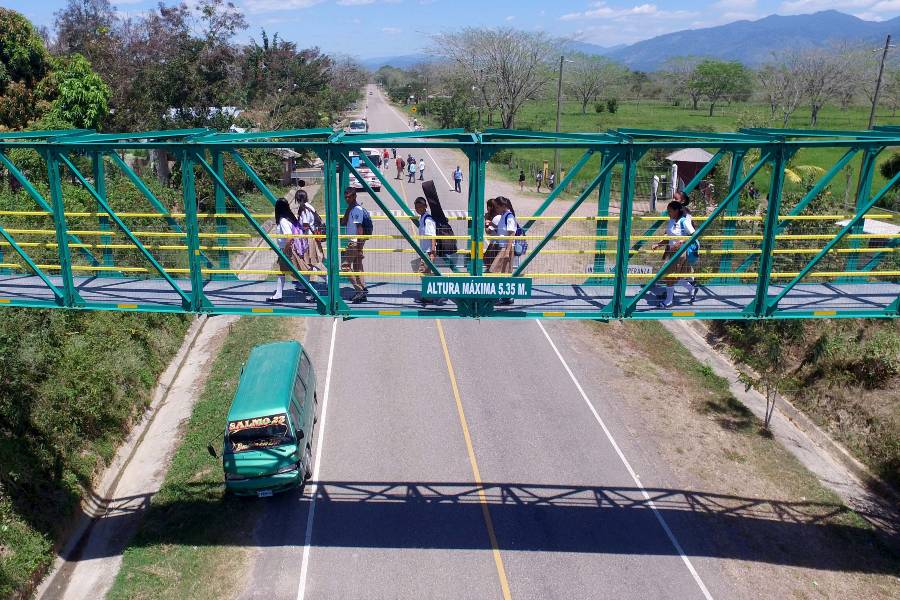
During construction of this bridge in San Estaben, Honduras, Juan Orlando Hernandez, the president of Honduras, visited the work site and expressed his gratitude for the project.
‘It was a God feeling’
Shortly after establishing the Peugeot Center, the college took on its largest project yet. A 104-foot-long metal pedestrian bridge was built over a highway in San Esteban, Honduras, to link two school campuses operated by Honduras Outreach International. The bridge ensured the safety of elementary and middle school students walking from one campus to the other to use needed facilities.
This project involved various government permits, work by an engineering firm in Honduras and a trial run construction project on Lipscomb’s campus, said Gwinn.
During prep and foundation work, Juan Orlando Hernandez, the president of Honduras, visited the work site and expressed his excitement and gratitude for the project. The highway was expected to become the main access to a new port facility under construction at the time, so it was sorely needed for the students’ safety.
In August 2015, engineering students and faculty assembled the metal bridge on the side of the highway, complete with decking, protective fencing and safety handrails. They also assembled a tower and stairs that were lifted in place by on-site crane operators to ensure that the bridge had enough clearance over the highway for trucks to pass underneath.
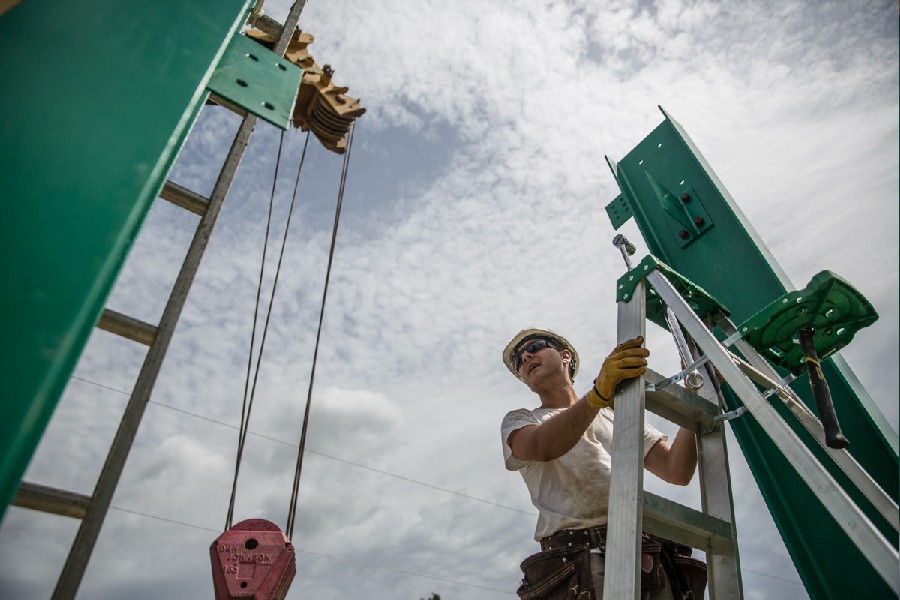
Ethan Johnson (’13), Lipscomb civil engineering alumnus, was the technical mentor for the San Esteban bridge project that won a national engineering award.
“It was really cool to see the reaction of the people in that community and how many people came out to see that bridge to be set up,” said Taylor Sanders (BS ’18). “It was a really good feeling that I can only express as a God feeling. It was God looking over that community for us.”
The American Council of Engineering Companies of Tennessee named three partners in the San Esteban project—HDR-ICA Engineering in Honduras, Lipscomb University and Honduras Outreach International—as the Grand Award winner in its small projects category in 2016.
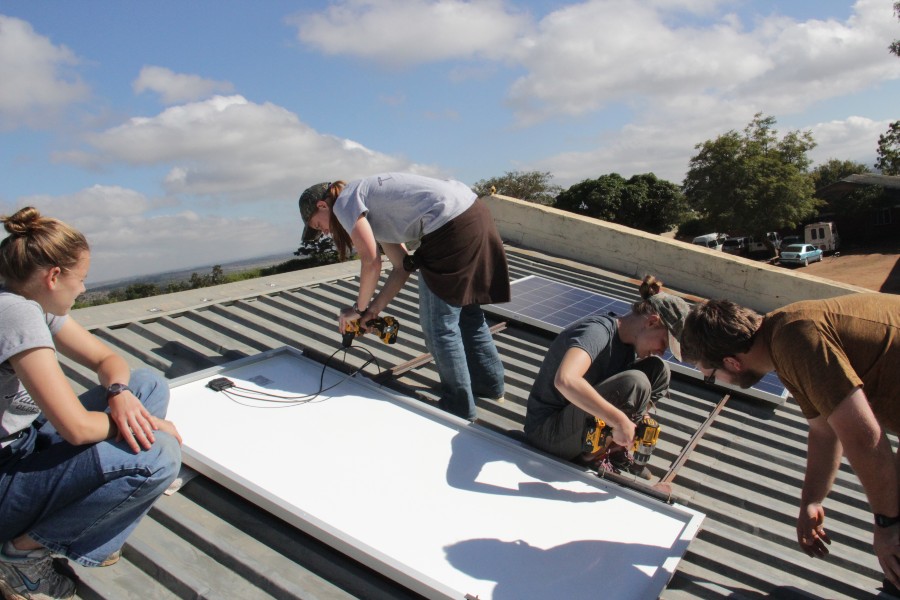
Installing solar panels for the Blessings Hospital in Malawi allows a reliable power back-up to store blood and vaccines at a constant cold temperature and for critical equipment and patient monitors in the ICU unit.
Everywhere, near and far, is a mission field
From that point, the Peugeot Center’s mission work has only grown and become more varied, with more partners and a broader reach, more on-site experiences offered to students each year and more participants from the local engineering industry involved.
Projects in Malawi, Ghana, Haiti and the Dominican Republic were completed, in addition to many more in Honduras and Guatemala. Projects of note include a playground for children with special needs for the Little Hands, Big Hearts ministry, a medical waste incinerator for Predisan, both in Honduras; and a solar panel installation to provide consistent power for the Blessings Hospital in Malawi.
In 2020, the engineering college was one of seven universities in the nation to receive a National Council of Examiners for Engineering and Surveying Engineering Education Award for a project to improve water sanitation for an orphanage and school in Ghana. The technical mentor for the project was George Garden, chief engineer, division of water resources for the Tennessee Department of Environment and Conservation.
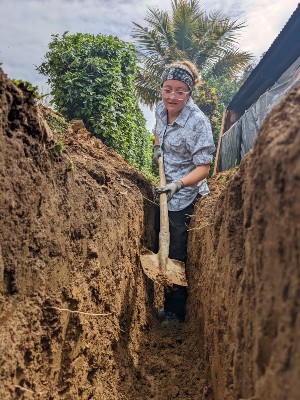
A student works to dig a trench for water pipes, part of a system to bring water to rural mountain communities in Guatemala, completed with partners Garney Construction, InFlo Design and Guatemalan non-governmental organization ADICAY.
Also in 2020, Kirsten Heikkinen Dodson (BS ’12), associate professor and chair of mechanical engineering and a product of engineering missions herself, was awarded a National Science Foundation grant to explore the impact of humanitarian engineering projects on student formation and their perspectives of workplace culture. She is now in the final year of the project which will wrap up with the design of a model for other engineering programs to utilize humanitarian engineering projects toward creating more inclusive and equitable engineers.
In 2019, a long-time partner of Lipscomb’s engineering missions, especially in Guatemala, became the new director of the Peugeot Center. Steve Sherman had previously worked closely with Lipscomb officials on projects through Health Talents International and coordinating projects in the Ulpan Valley.
As it did for the rest of the globe, 2020 and Covid-19 pandemic travel restrictions brought a shift in focus for the Peugeot Center, which pivoted to use the college’s laser cutter and other equipment to produce more than 11,000 plastic face shields to distribute to health care workers, educators and others in need.
Shifting focus away from international work allowed the Peugeot Center to open new doors for local projects, most notably installing solar panels on 15 micro-homes used as temporary housing for homeless individuals on the property of the Green Street Church of Christ in Nashville. David Elrod (BS ’77), now dean of the engineering college, oversaw student work days to install the panels, and more recently has led the effort to construct a new micro-home for the community alongside freshman engineering students.
Micro-home projects have become a valuable tool to help freshmen students learn the basics of engineering design and real-world applications, said Elrod.
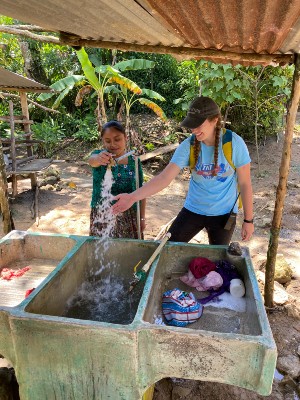
Because of ADICAY’s work to involve the community itself in installation and its education of locals on system maintenance, the engineers estimate that the systems will provide clean water for communities for the next 20-50 years.
Most recently, the Peugeot Center has made great strides in bringing water to rural mountain communities in Guatemala through partners Garney Construction, the largest water/wastewater contractor in the U.S., InFlo Design and Guatemalan non-governmental organization ADICAY.
Continuing a formula established in 2006, ADICAY provides in-country resources and coordination of community members to do preparatory work such as topographical surveys, legal contracts and initial construction, said Sherman.
Because of ADICAY’s work to involve the community itself in installation and its education of locals on system maintenance, the engineers estimate that the systems will provide clean water for communities for the next 20-50 years.
The women of the villages often invite team members into their homes for meals or refreshments, and the children “follow all of the team members around throughout the installation, eager to pitch in and learn how it all works,” said Daniela Baugh (BS ’16), another engineering alumna who has returned to serve as the Peugeot Center’s director of operations. “These projects are truly a partnership, not just a gift.”
Garney is an employee-owned company whose leaders actively seek opportunities to carry out the company’s purpose: “Building sustainable futures with the world’s most precious resources—water and people.” The company has not only financially supported the Peugeot Center, but it has sent many of its leaders and employees on the mission experiences to both mentor the students and gain deeper understanding of how their daily work impacts lives for the better.
“It makes their work feel valued when they see the excitement of someone who can turn on their water tap for the first time,” said Sherman. “Even though people in America don’t think anything of it, their company realizes this water is blessing cities and people.”
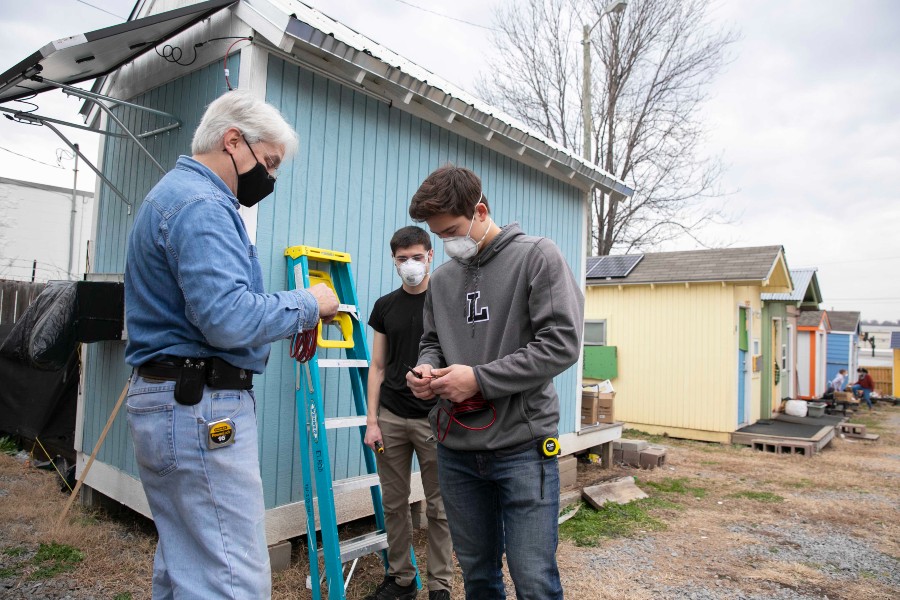
David Elrod (BS ’77), now dean of the engineering college, oversees students installing solar panels on microhomes in Nashville. Micro-home projects have become a valuable tool to help freshmen students learn the basics of engineering design.
The heart of an engineering
Twenty years on, one water tank in Honduras has turned into a cascading river of projects that have impacted thousands of people in underserved areas of the world. One idea sparked by a handful of students has become sustainable improvement for those in need across the globe.
“When you take these trips, you know you are doing the will of God,” said Fann. “On these trips, you are exactly where God wants you to be, because you are doing His will, You are not distracted by life. For two weeks, you can focus on doing exactly what God wants you to do.”
For engineering graduates, that service doesn’t stop when they go home. “What is exciting to me about being an engineer is that the heart of engineering is to be a servant,” said Hatchell. “To help communities grow, develop and to come alongside people who have problems that they are not sure how to solve.”